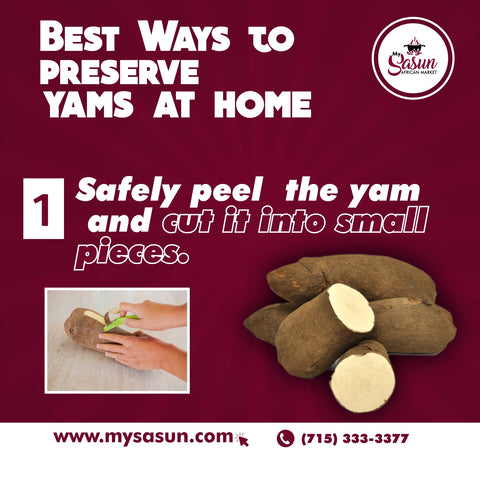Yam is a delicious and nutritious staple food that many people enjoy. But how do you store it properly to prevent it from spoiling or losing its color and taste? In this post, we will share with you some tips and tricks on how to preserve yam effectively.
What Causes Yam to Discolor and Spoil?
Yam is a type of tuber that has a brown skin and a white or yellow flesh. It is very popular and widely grown in Nigeria, where it is exported to other countries. However, yam is also very sensitive to storage conditions and can easily deteriorate if not handled well.
One of the main problems with yam is that it tends to oxidize and change color when it is peeled and exposed to air. This can affect its appearance and quality. Some varieties of yam are more resistant to oxidation than others, such as the white yam, which stays white even after peeling. But others can turn yellow, green, brown, or black, depending on the type of yam and the duration of exposure.
Another problem with yam is that it can spoil due to bacterial or fungal growth, especially if it is stored in a warm and humid environment. This can cause the yam to rot, smell bad, or become unsafe to eat.
Also Read: POUNDED YAM VERSUS POUNDO YAM
How to Prevent Yam from Discoloring and Spoiling?
There are two main methods that you can use to preserve yam and keep it fresh and tasty for a long time. These are:
- The Water Submersion Method: This is a simple and common method that involves peeling the yam and immersing it in water as soon as possible. Some people even peel the yam under water to avoid any contact with air. This method helps to prevent oxidation and discoloration of the yam. However, it is not always effective, as sometimes the yam can still change color slightly or lose some of its flavor.
- The Freezing Method: This is a more reliable and convenient method that involves cutting and storing the yam in the freezer. This method helps to preserve the yam's color, taste, and texture for a long time. Here are the steps to follow for this method:
- Fill a bowl with water and set it aside.
- Cut and peel the yam into circular or square pieces. Put the peeled yam in the bowl of water to prevent oxidation. Repeat this until you have cut all the yam that you want to preserve.
- Wash the yam pieces until they are clean and free of dirt. Then drain them in a colander.
- Put the yam pieces in a large Ziploc bag. Do not overcrowd or stack them. Add a tablespoon of baking soda to the bag. This helps to prevent bacterial growth.
- Seal the bag and remove as much air as possible. Place the bag in the freezer and freeze. The yam can last for 3 months to 1 year in the freezer.
- When you want to cook the yam, do not thaw it. Just put it directly into boiling water from the freezer. This helps to retain its freshness and flavor.
Also Read: GOAT MEAT AND YAM PEPPER SOUP THAT WENT TO HARVARD
Note: You can also use other preservatives like lemon juice, salt, or vinegar instead of baking soda. These can also help to prevent discoloration and spoilage of the yam.
Rounding Off:
We hope you found this post helpful and informative. If you have any questions or comments, please feel free to contact us. And don't forget to check out our online store for the best quality and variety of African foods and products. Thank you for choosing My Sasun African Store!







Comments (3)
I thought the physicians says there is no cure for HSV 2!!! I am telling you today that Dr ahonsie cure HSV 2 with his herbal medicine and once you get cured you are cured forever it is never reversible, I have been suffering for this deadly disease called h HSV 2 for more than a 2years and lost all hope because my doctor says there is no cure for HSV 2. Brethren I saw a testimony on the internet on how Dr ahonsie cure HSV, Hapatitis etc with his herbal medication and an email and watsapp to contact him was also displayed, I thought this was joke but I decided to contact him and he replied telling me not to worry that my problem is over . Dr ahonsie sent me a herbal medication to drink for one month but only 2weeks I feel strange and I went to my doctor and he confirmed me negative. He can help you too. Contact him drahonsie00@gmail.com or whatsapp +2348039482367 https://drahonsie002.wixsite.com/dr-ahonsie https://www.facebook.com/drstellaherbalhome?mibextid=ZbWKwL
Being the winner of a multi-million-dollar lottery certainly is a life-changing event for almost every single lottery winner. My name is Mavis Wanczyk from Chicopee, Massachusetts, the famous Powerball lottery winner of $758 million (£591m). I know many people would wonder how I had won the lottery. Would you believe me if I told you that I did it with spell casting? I met this famous spell caster known as Great Odunga and he was the one who did it for me. As shocking as it was to me, my famous comment to the press was “ I’m going to go and hide in my bed.” Never did I believe that Great Odunga made me wealthy overnight. If you want to have your chance of winning and becoming very wealthy just like me, contact Great Odunga at odungaspelltemple@outlook.com OR Email: odungaspelltemple@gmail.com and WHATS-APP HIM at +2348167159012 and you will be lucky. Thanks for reading and hope to see you at the top
My Sasun African Market,
I really appreciate you for this article on how to preserve yam.. I want to start a yam business in the UK. I needed a mentor but those in the business shy away from talking about it..I dont understand why. So I decided to look it up online and there you were, a God sent..Iwith all the questions in my heart you answered…. I do appreciate you.I pray God blesses you beyond man’s imagination in Jesus name amen.
Thank you.
Audrey.